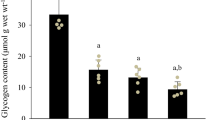Abstract
Anin vitro preparation of electrically stimulated sartorius muscle of the frog was used as a model to investigate the effects of insulin and testosterone on the increased glycogen content of frog skeletal muscle that was observedin vivo 48 h after an exhaustive bout of treadmill exercise. Thein vitro preparation could effectively extract glucose from the bathing medium and continue glycogen synthesis for incubation periods up to 60 h, and the electrical stimulation depleted glycogen by 68%. Electrical stimulation enhanced rates of glucose uptake and glycogen synthesis when these variables were measured after prolonged periods of poststimulation incubation but did not cause an overshoot of glycogen storage similar to that observedin vivo. Stimulation did not produce increments in glycogen synthesis that were additive to those of insulin or testosterone. The absence of glycogen overshoot in thein vitro system may have resulted from the absence of neural factors.
Similar content being viewed by others
References
Bass, E., Gutmann, A. E., Vodicka, Z.: Resynthesis of glycogen in muscle after stimulation. Physiol. bohemoslov.4, 267–275 (1955).
Bergamini, E.: Additive effects of testosterone and insulin on glycogen content and 2-deoxyglucose phosphorylation in rat levator ani muscle. Biochim. biophys. Acta (Amst.)177, 235–240 (1969a).
Bergamini, E.: Testosterone and sugar transport in levator ani muscle of rat. Biochim. biophys. Acta (Amst,)193, 193–202 (1969b).
Bergamini, E., Bombara, G., Pellegrino, C.: Synthesis of glycogen under the influence of testosterone in the levator ani of castrated rats. II. Activity of hexokinase, phosphoglucomutase, UDPG-pyrrophosphorylase, UDPG-glycogen-1,4-glycosyltransferase and glycogen phosphorylase. Boll. Soc. ital. Biol. sper.42, 1537–1540 (1966).
Bergstrom, J., Hultman, E.: Muscle glycogen synthesis after exercise: an enhancing factor localized in the muscle cells in man. Nature (Lond.)210, 309–310 (1966).
Danforth, W. H.: Glycogen synthetase activity in skeletal muscle. Interconversion of two forms and control of glycogen synthesis. J. biol. Chem.240, 588–593 (1965).
Edgerton, V. R., Barnard, R. J., Peter, J. B., Simpson, D. R., Gillespie, C. A.: Response of muscle glycogen and phosphorylase to electrical stimulation in trained and nontrained guinea pigs. Exp. Neurol.27, 46–56 (1970).
Gillespie, C. A., Edgerton, V. R.: The role of testosterone in exercise-induced glycogen supercompensation. Hormone Metabol. Res.2, 364–366 (1970).
Goldstein, M. S., Mullick, V., Huddlestun, B., Levine, R.: Action of muscular work on transfer of sugars across cell barriers: comparison with action of insulin. Amer. J. Physiol.173, 212–216 (1953).
Harris, A. J., Miledi, R.: A study of frog muscle maintained in organ culture. J. Physiol. (Lond.)221, 207–226 (1972).
Holloszy, J. O., Narahara, H. T.: Studies of tissue permeability. X. Changes in permeability to 3-methylglucose associated with contraction of isolated frog muscle. J. biol. Chem.240, 3493–3500 (1965).
Jeffress, R. N., Peter, J. B., Lamb, D. R.: Effects of exercise on glycogen synthetase in red and white skeletal muscle. Life Sci.7, 957–960 (1968).
Krebs, H. A.: Body size and tissue respiration. Biochim. biophys. Acta (Amst.)4, 249–269 (1950).
Lamb, D. R., Peter, J. B., Jeffress, R. N., Wallace, H. A.: Glycogen, hexokinase, and glycogen synthetase adaptations to exercise. Amer. J. Physiol.217, 1628–1632 (1969).
Mondon, C. E., Burton, S. D.: Factors modifying carbohydrate metabolism and effect of insulin in perfused rat liver. Amer. J. Physiol.220, 724–734 (1971).
Morgan, T. E., Cobb, L. A., Short, F. A., Ross, R., Gunn, D. R.: Effects of long-term exercise on human muscle mitochondria. In: Pernow, B., Saltin, B. (Eds): Muscle metabolism during exercise, p. 87–95. New York: Plenum Press 1971.
Narahara, H. T., Ozand, P., Cori, C. F.: Studies of tissue permeability. VII. The effect of insulin on glucose penetration and phosphorylation in frog muscle. J. biol. Chem.235, 3370–3378 (1960).
Nelson, N.: A photometric adaptation of the Somogyi method for the determination of glucose. J. biol. Chem.153, 375–380 (1944).
Saltin, B., Karlsson, J.: Muscle glycogen utilization during work of different intensities. In: Pernow, B., Saltin, B. (Eds.): Muscle metabolism during exercise, p. 289–299. New York: Plenum Press 1971.
Van Handel, E.: Estimation of glycogen in small amounts of tissue. Anal. Biochem.11, 256–265 (1965).
Villar-Palasi, C.: The hormonal regulation of glycogen metabolism in muscle. Vitam. and Horm.26, 65–118 (1968).
Wilkie, D. R.: The function of muscle in the whole animal. In: Davson, H., Eggleton, M. G. (Eds.): Principles of human physiology, p. 850–861. Philadelphia: Lea and Febiger 1968.
Author information
Authors and Affiliations
Rights and permissions
About this article
Cite this article
Stumpfhauser, L., Lamb, D.R. Glycogen content and glucose uptake in stimulated frog sartorius muscle: Effects of prolonged incubation, insulin, and testosterone. Int. Z. Angew. Physiol. Einschl. Arbeitsphysiol. 31, 163–172 (1973). https://doi.org/10.1007/BF00697596
Received:
Issue Date:
DOI: https://doi.org/10.1007/BF00697596




